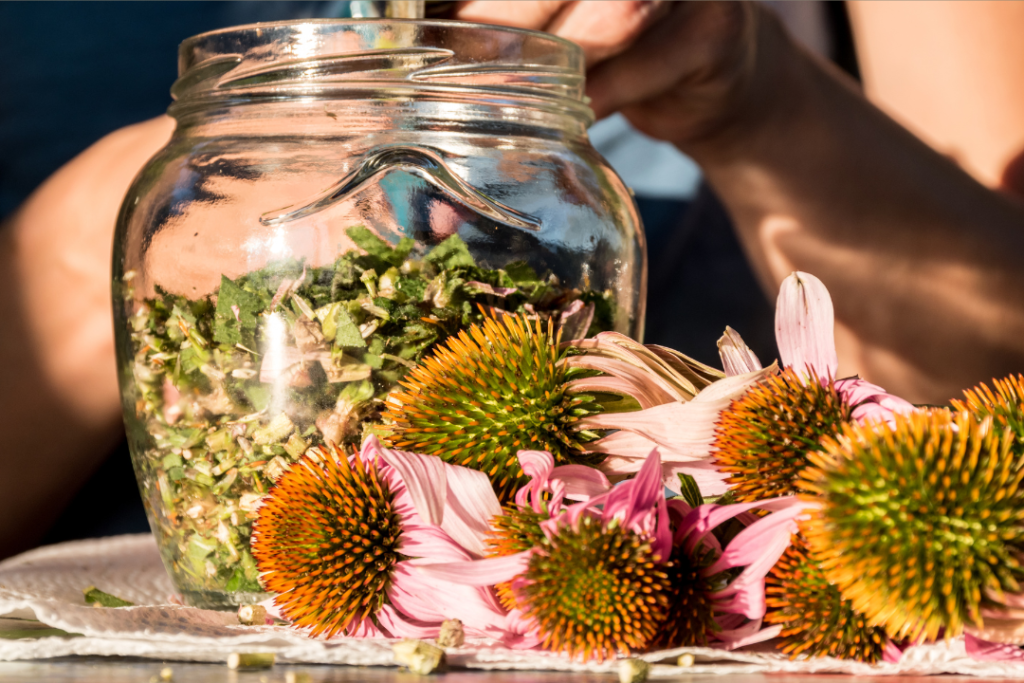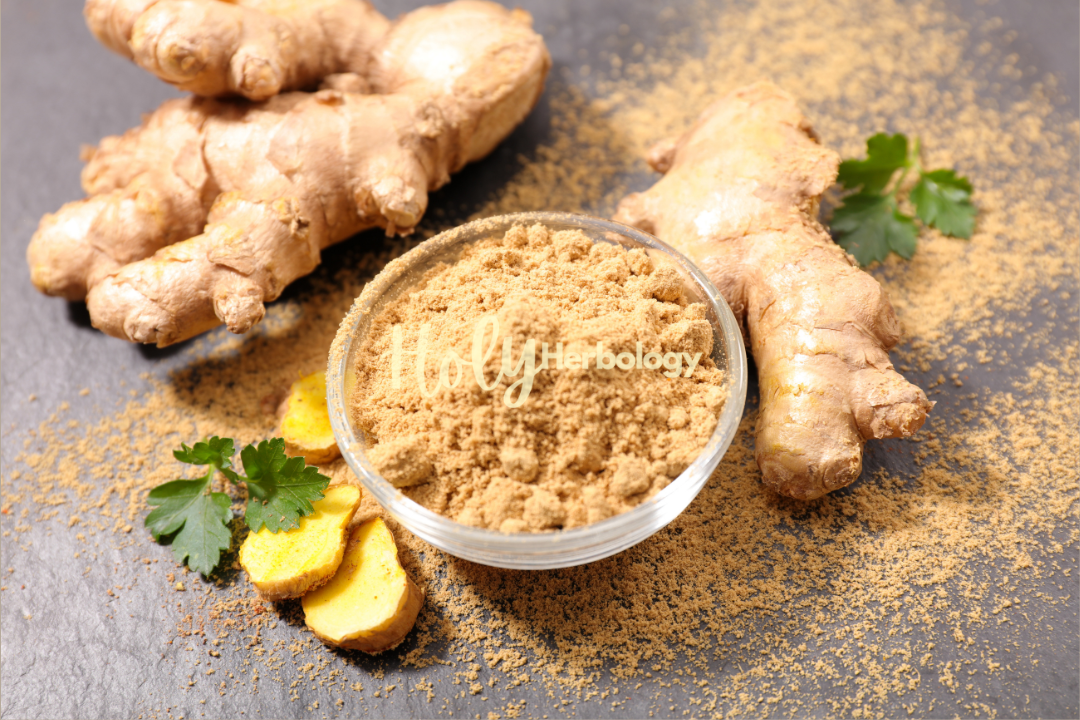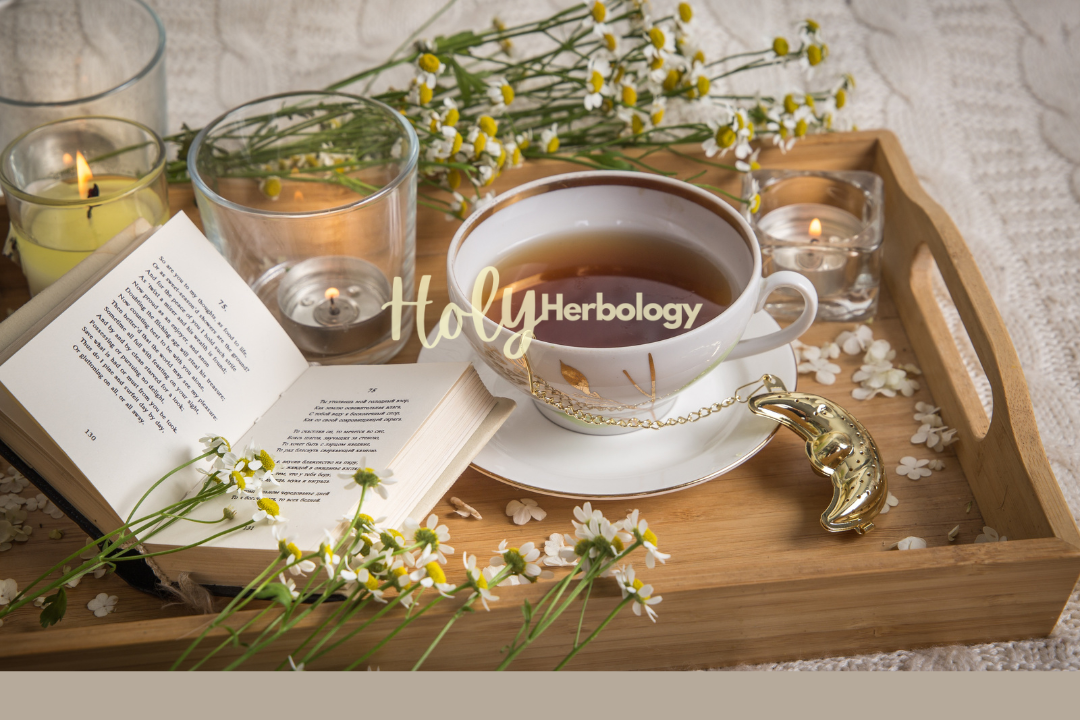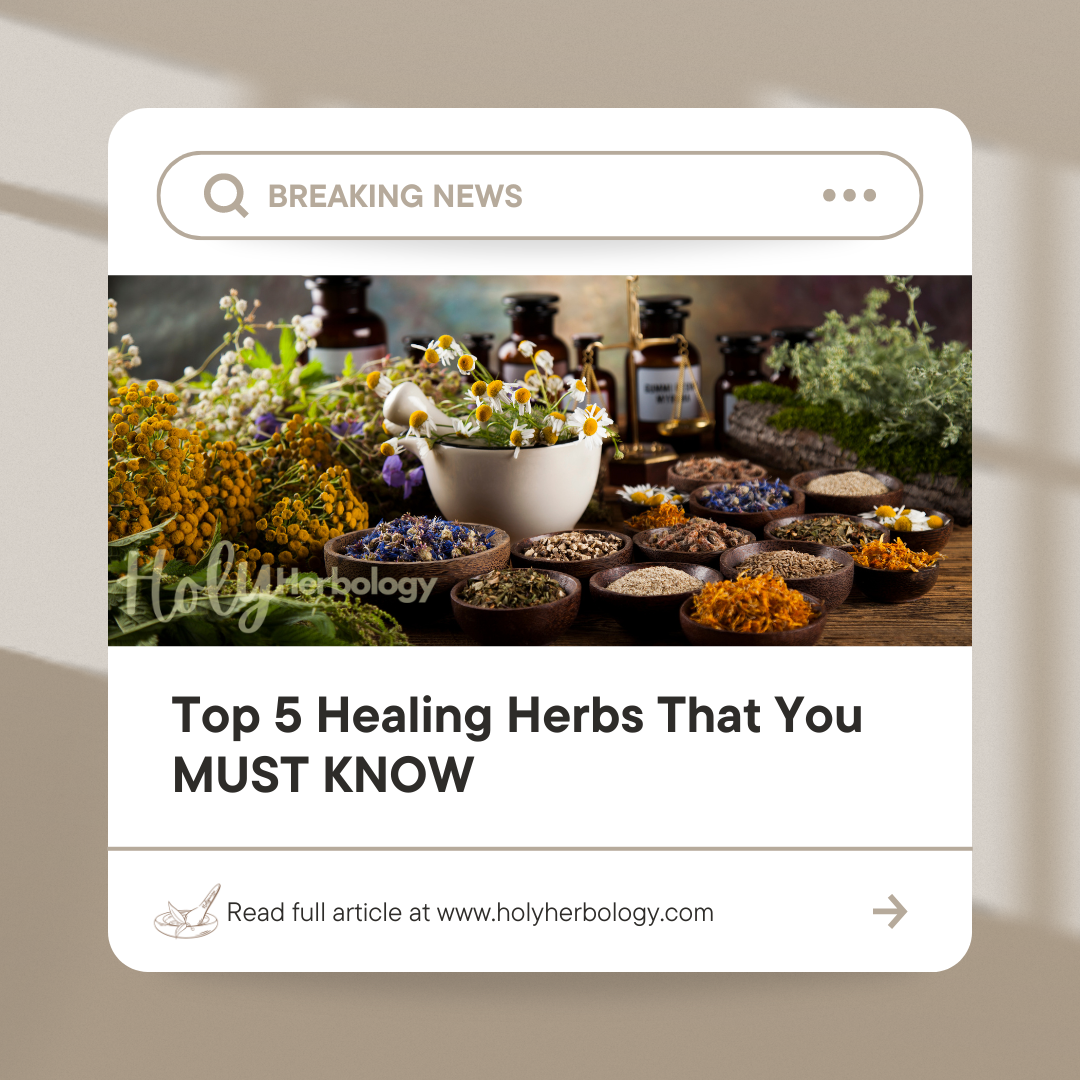Embrace Nature’s Healing Power
In a world where we have sadly been convinced that synthetic medicines are superior to its original and natural source, we overlook the healing powers that nature has given humanity for millennia. Imagine tapping into that ancient knowledge today. Here at Holy Herbology, our commitment to you is one of providing this timeless wisdom and also the amazing natural resources it encompasses. Here, we are going to enlighten our readers in the world of the top five healing herbs you should know, including Echinacea, Lavender, Peppermint, Ginger, and Chamomile. Each will be discussed in great detail, from a brief history of the herb to its striking color, use, preparation method, and key safety issues. Let us begin with a magically immune fighter called echinacea.
1. Echinacea: The Immune Booster

Historical Context
Echinacea, or purple coneflower, is indigenous to North America and has been used by Native American tribes for centuries. Traditionally, it was used to treat infections, wounds, and snakebites because of its powerful healing properties. During the 18th and 19th centuries, echinacea’s popularity swept over to Europe, where the practice tacked onto traditional European herbal medicine practices.
Color and Healing Properties
Echinacea gets its purple color from anthocyanins, a family of renowned antioxidants that protect cells from oxidative stress and are anti-inflammatory. The deep, shining purple color is very striking to the eye and indicative of health-promoting attributes of this plant.
Primary Use: Immune System Support
Echinacea is primarily known to stimulate the immune system. Some studies indicate that it increases the number of immune cells in action as well as the production of antibodies and improves the general capacity of the body to resist infection. It has been taken chiefly to decrease the gravity of, and to shorten the duration of, colds and flu.
Secondary Use: Anti-Inflammatory Effects
Apart from its immune-boosting properties, echinacea has anti-inflammatory actions. It has been administered to many patients over the years who suffer from inflammatory ailments such as arthritis and skin conditions like eczema and psoriasis. Anti-inflammatory constituents in echinacea reduce swelling and redness, thus making it quite effective for both internal and topical uses.
Tertiary Use: Wound Healing
Wound healing with Echinacea was one of the well-recognized applications by Native Americans in cases involving various skin injuries, cuts, and burns. It improves wound healing through the rapid increase in the production of collagen and reduces the risk of infection due to its antimicrobial activity.
Preparation Methods
Echinacea is taken in many different ways, but the most common ways are through teas, tinctures, capsules, and extracts. The roots, leaves, and flowers of this plant are used for medicinal purposes. The most common means of taking this herb for an immune-enhanced status are the teas and tinctures.
- Tea: Steep dried leaves or flowers of echinacea in hot water for 10 to 15 minutes to make the echinacea tea. Since the above preparation is mild, one can take it up daily for boosting immunity.
- Tincture: Tinctures are brewed by steeping echinacea in alcohol or vinegar. These are concentrated products given in small dosages and are stronger than the tea variety. Many prefer to start with tinctures the moment there is suspicion of any illness.
- Capsules: Echinacea is available in the form of capsules for convenience, while a standardized amount of this herb is administered.
Actions and Energetics (For more information on Actions and Energetics, click here)
Imagine your immune system as an army preparing for battle. Echinacea is that drill sergeant, rallying your body’s defenses and pushing them to stand guard against invaders. Its energetic profile? Bold, warm, and stimulating. Echinacea seems to ignite a fire in your cells, urging them to fight off infections before they can even settle in. But here’s the magic: it doesn’t just arm you for physical health—it feels like it bolsters emotional resilience too, as if saying, “You’re stronger than you think.” The herb is known for its ability to sweep through lingering fatigue and mental fog, especially after illness, restoring clarity and a sense of readiness. With echinacea, you’re in full warrior mode—ready to face whatever life throws your way.
Safety and Precautions
While echinacea is well tolerated, safe for short-term use; with prolonged intake or in high dosages, it may provoke adverse effects, such as gastrointestinal discomfort, allergic reactions-especially among plant allergy sufferers, particularly from the Asteraceae family. Echinacea preparations are recommended to be used under the guidance of a healthcare professional, especially in autoimmune diseases and when immunosuppressive drugs are involved.
2. Lavender: The Calming Healer

Lavender’s versatile uses, from ancient baths to modern skincare, make it a timeless remedy
Historical Context
Lavender, with its soothing fragrance and medicinal properties, has been cherished for thousands of years. Did you know that the ancient Romans used it in their baths for relaxation, while ancient Egyptians utilized lavender in the mummification process and for perfume? Imagine that! Lavender gets its name from the Latin word “lavare,” which means “to wash,” highlighting its long-standing association with cleanliness and purity.
Color and Healing Properties
Lavender’s delicate purple color is associated with tranquility and relaxation. The color signifies the presence of linalool and linalyl acetate, which are both compounds responsible for its calming and sedative effects. Purple is often linked with peace, which is fitting for lavender’s role in stress relief and sleep promotion.
Primary Use: Anxiety and Stress Relief
Among these, lavender has continuously come into the spotlight for its anxiety and stress-soothing properties. There have been studies revealing that breathing in the fragrance of lavender essential oil reduces heart rate and blood pressure because of the nervous system’s sedation. The anxiolytic properties make it a popular choice for aromatherapy.
Secondary Use: Sleep Aid
The herb lavender is a natural sedative that will help improve the quality of sleep. This plant provides a very soothing aroma, which helps in relaxing one’s self; it prepares your body for rest. It forms one of the effective remedies for insomnia and restless nights. The essential oil of this plant is used in diffusers or applied to bath products for sleeping purposes, while some people just apply it directly on their pillows for a good sleep.
Tertiary Use: Skin Care and Healing
This makes it an ingredient very suitable for usage in skincare, given that lavender possesses very strong antibacterial and anti-inflammatory properties. Minor burns and cuts, insect bites, and skin diseases like acne are treated with lavender. The mechanism of action of lavender oil on irritated skin involves soothing the skin by offering relief to redness and aiding in accelerating the pace of recovery.
Preparation Methods
Lavender may come in essential oils, dried flowers, and extracts, each with specific usage and application depending on the needs or results desired.
- Essential Oil: The lavender essential oil is of a very heavy concentration and may be used in vaporizers for aromatherapy or diluted with some carrier oil for topical use.
- Dried Flowers: These dried flowers can be used to make tea, put in your bathwater, or even in sachets to release their sweet and calming fragrance. From this, tea may be prepared by steeping it in hot water for 5 to 10 minutes.
- Infusions: These can be done in oils or honey for culinary purposes, placing this distinctive flavor into desserts or drinks.
Actions and Energetics
Lavender is like a gentle breeze after a storm, offering calmness in a world that operates on overdrive. But this flower is more than just relaxing; it holds a quiet strength. Its cool, soothing energy wraps around you, quieting anxiety like a warm hug on a cold night. Lavender invites balance to an overworked nervous system, helping you catch your breath when life gets overwhelming. It’s also a profound healer in quieting tension headaches and even muscle spasms with its soft touch. But lavender’s true magic lies in its ability to soothe both mind and body—like a lullaby whispered through the air, it ushers in peace, stillness, and that much-needed space to just be. It’s the ultimate plant for those craving a quiet amongst life’s many storms.
Safety and Precautions
Lavender, in general, is safe because it is usually utilized in moderation. However, lavender essential oil, undiluted, may cause skin irritation in sensitive persons. A patch test should be done before topical application. Internal consumption of lavender in huge amounts, especially the essential oil, is toxic and needs to be avoided. Pregnant women and small children should use lavender with caution and only after consulting a health practitioner.
3. Peppermint: The Digestive Aid

Whether sipping peppermint tea after a heavy meal or inhaling its refreshing aroma when feeling congested, peppermint remains a go-to herb in every home
Historical Context
Peppermint has been used as medicine dating all the way back to ancient Egypt, Greece, and Rome times. The Egyptians harvested peppermint and included it in their medical texts, while both Greeks and Romans used it to flavor wine and aid digestion. Peppermint was and STILL IT highly valued for its refreshing taste and healing properties.
Color and Healing Properties
The green leaves of peppermint reflect its high amount of chlorophyll, an effective detoxification agent and supporter of general health. Green is also the color of life and freshness, accurately describing peppermint’s refreshing and invigorating results on both body and mind.
Primary Use: Digestive Health
Peppermint is well known for its power of easing indigestions. Menthol has the natural effect of relaxing the smooth muscles along the gut, and this makes peppermint effective in the soothing of indigestion, bloating, and symptoms of IBS. Peppermint teas are thus very common in cases of stomach complaints.
Secondary Use: Respiratory Relief
Another very good effect of peppermint is that menthol acts as a natural decongestant, clearing your sinuses, relieving nasal congestion, and easing breathing. Peppermint steam or diffused peppermint oil will relieve the symptoms of cold and flu.
Tertiary Use: Headache Relief
Peppermint oil has become a popular remedy for tension headaches. It has a cooling and analgesic effect, which helps relax muscles and reduce headache symptoms when applied to the temples and forehead in a diluted form.
Preparation Methods
Peppermint is a versatile herb available to be used as fresh or dried leaves, essential oils, and in capsule forms.
- The peppermint tea is prepared by steeping fresh or dried leaves in hot water. This cool drink is an antidote to digestive disorders and may be taken both at hot and cold temperatures.
- Peppermint essential oil is highly concentrated; therefore, it needs to be diluted with a carrier oil prior to topical application. It can readily be added to diffusers, bath water, and massage oils.
- Fresh peppermint leaves can be used in salads, blended into smoothies, or as a garnish to add that refreshing burst of flavor.
Actions and Energetics
Peppermint is the cool breeze that clears the air—mentally, physically, and emotionally. It’s that refreshing clarity you feel when you step outside and take a deep breath. Peppermint’s energy is invigorating, crisp, and light, yet it holds an edge of sharpness, cutting through mental fog and physical congestion with precision. It stimulates without overwhelming, awakening the mind while relaxing tense muscles. Whether it’s easing a stomach ache or offering a burst of focus in the middle of a long day, peppermint has an incredible ability to refresh the spirit. It says, “Here, let’s start again,” and offers clarity when things feel muddled. In its essence, peppermint is the rejuvenator—clearing pathways, opening space, and helping you move forward with renewed energy.
Safety and Precautions
While peppermint is believed to be harmless for the majority of people, this plant can cause allergic reactions in sensitive ones. One should not use it in great amounts because concentrated oil may provoke such adverse reactions as skin irritation. One should not get peppermint oil into one’s eyes and mucous membranes. People with GERD should avoid the use of peppermint because it can worsen the symptoms, and in these cases, this plant should be used very cautiously.
4. Ginger: The Anti-Inflammatory Powerhouse

If you’ve ever felt queasy or had an upset stomach, a simple ginger tea or a ginger ale might be your best natural remedy.
Historical Context
Can you believe that ginger is thought of to be one of the oldest medicinal spices known to man. Dating back over more than 5,000 years, ginger originates from Southeast Asia and spread to many areas because of its numerous health benefits. Ancient Chinese and Indian cultures favored the root as it produces a warming effect and is able to help with various issues, including digestion and nausea.
Color and Healing Properties
Ginger’s warm yellow color is attributed to the presence of curcuminoids and gingerol, compounds that possess powerful anti-inflammatory and antioxidant properties. The yellow hue signifies energy and vitality, reflecting ginger’s ability to invigorate the body and mind.
Primary Use: Anti-Inflammatory and Pain Relief
Ginger is also recognized to contain anti-inflammatory properties that are helpful in pain and inflammation related to arthritis and muscular soreness. The bioactive compound present in ginger, referred to as gingerol, has been said to inhibit the production of chemicals in the body that cause inflammation.
Secondary Use: Nausea Relief
Ginger is a time-tested medicine that, in fact, brings about instant relief from nausea and vomiting. Besides motion sickness, it’s very effective against pregnancy-induced morning sickness and nausea after surgery. It acts by stimulating the digestive tract, thereby increasing the speed at which the stomach empties itself.
Tertiary Use: Immune Support
Ginger has antimicrobial properties that can help boost the immune system. Its warming effect increases circulation, which helps the body fight off infections and illnesses. Ginger tea is commonly consumed during cold and flu season to enhance immunity and relieve symptoms.
Preparation Methods
Ginger is versatile and has many uses; it can be applied a number of ways: fresh, dried, powdered, as oil, or juice.
- Tea: Fresh ginger tea is made by infusing slices of fresh ginger root into hot water. It can be even more comforting if sweetened with natural raw honey and lemon for additional health benefits and a splash of goodness .
- Fresh: Raw ginger can be grated or sliced and added to dishes, soups, and smoothies for the spicy kick and also for health benefits.
- Capsules: Ginger is also available in supplement form to be used conveniently, particularly by people who suffer from chronic inflammation or indigestion.
Actions and Energetics
Ginger is fire. It’s the spark you need when your system is sluggish, the heat that burns through cold, damp stagnation in both the body and the mind. It’s the remedy you reach for when life feels slow, helping to rekindle your inner flame. Ginger’s energy is fiercely warming, driving circulation and awakening every cell in your body to move, to act, to live fully. It’s not just a digestive aid—it’s a reminder that the fire within can transform weakness into power. Whether your muscles are stiff from the cold or your mind is stuck in indecision, ginger brings with it the vitality you need to break through. In essence, ginger is your personal wake-up call, shaking off inertia and inviting you to step forward into your own strength.
Safety and Precautions
Ginger is generally nontoxic and considered safe by most persons in moderate use. The excessive use of ginger may cause GI distress: heartburn, diarrhea, and even hemorrhaging. Individuals on anticoagulant medications should be very cautious with ginger due to its potential to enhance the action of these drugs. Pregnancy requires special caution with the use of ginger to alleviate morning sickness.
5. Chamomile (kah-muh-MILL-ah): The Gentle Soother

Picture yourself winding down at night with a warm cup of chamomile tea, knowing it’s not only calming but great for your skin too
Historical Context
Chamomile has been used for centuries as a natural remedy for relaxation and healing. Ancient Egyptians revered chamomile for its healing properties and used it to treat fevers and as a cosmetic. The Greeks and Romans also valued chamomile for its calming effects and included it in their medicinal practices.
Color and Healing Properties
The flowers of chamomile are white with yellow centers, symbolizing purity, tranquility, and gentleness. In this manner, these colors express the properties of chamomile for calmness and soothing. The flowers contain apigenin-a compound known for its mild sedative and anti-inflammatory effects.
Primary Use: Sleep Aid and Relaxation
Chamomile is most famous for its tranquillizing and sedative actions. Chamomile tea, being a bedtime drink, is normally taken before sleeping to have proper sleep with improved quality of sleep. Its gentle nature makes it suitable for adults and children alike.
Secondary Use: Digestive Health
It has anti-inflammatory and antispasmodic properties, hence acting effectively for the relief of digestive issues like bloating, gas accumulation, and indigestion. In this way, it soothes stomach lining and diminishes nausea.
Tertiary Use: Skin Care
Chamomile consists of anti-inflammatory and antibacterial components; it is thus consumable for skin care. Skin irritations, eczema, or minor cuts can be treated by the herb. It is consumed in skin lotions and creams to soothe and hydrate skin.
Preparation Methods
Chamomile is usually prepared and taken as tea, essential oil, or incorporated into skincare products.
- Tea: Chamomile tea is an infusion of dried flowers of chamomile in hot water. It is a gentle and mild tea that can be consumed daily to help with relaxation and digestive support.
- Chamomile Essential Oil: Chamomile essential oil in aromatherapy can be added into bathwater or diffused to induce relaxation and reduce stress.
- Topical: Chamomile can be steeped into oils and also added to creams for a topical application to soothe skin irritations and help them heal.
Actions and Energetics
Chamomile is like an herbal grandmother-soothing, rocking, and telling one that everything will be all right, humming a sweet lullaby. This is sweet medicine, its warmth melting tension like morning sunlight on a winter day. Chamomile acts much more than as a simple sedative; rather, it may have a protective action on the nervous system, lulling one into deep rest when life becomes too hard. Chamomile soothes the gut like a mother soothes a colicky baby, calming digestion when anxiety or stress turns your stomach into knots. It has soft energy that is formidable, just like an older friend who seems to know exactly what to say and do at precisely that moment to comfort you. Chamomile teaches that rest is not weakness but, in fact, returning to strength-thru a much-needed pause in this restless world.
Safety and Precautions
It is nontoxic to most people but owing to its classification among the Asteraceae plant family, it easily provokes allergic contact dermatitis among susceptible people. The usual precautionary measures including a patch test should be taken before topical application of chamomile. Pregnant and lactating women may also consult a healthcare professional before using chamomile during their respective health conditions, since this may affect uterine contractions. This should be judiciously used in patients taking anticoagulant medications.
Did You Know?
Did you know that the healing properties of these top five herbs have been supported by both ancient wisdom and modern science?
These herbs remain of benefit to us, even in this modern age, at a time when we seek natural alternatives to synthetic treatments.
Let’s dive into some interesting facts:
- Echinacea’s Immune-Boosting Secret: Studies have indeed shown that Echinacea increases the number of white blood cells, which are important in fighting infection. According to one study published in the Journal of Clinical Pharmacy and Therapeutics, it was indicated that Echinacea reduces the chances of developing colds by more than 50%, besides shortening the duration of symptoms related to colds for 1-4 days, making it one of the most common naturopathic remedies during cold and flu seasons. The knowledge could then explain why the herb was a “cure-all” to the ancient Native Americans.
- Lavender’s Stress-Relief Power: Many studies have proven the potential of this sweet fragrance of lavender to efficiently lower anxiety levels. This includes a 2012 study published in the International Journal of Psychiatry in Clinical Practice, which demonstrated that an extract of lavender oil called Silexan was effective against symptoms of anxiety, similarly to lorazepam-a very widely prescribed anti-anxiety drug. So the next time you feel too overwhelmed, try diffusing some lavender oil or add it to your bath for a natural way to relax.
- Peppermint for Digestive Health: According to a study in the British Medical Journal, peppermint oil has been shown to effectively treat IBS by relaxing the muscles of the gastrointestinal tract with its menthol. In this way, it reduces symptoms like bloating, gas, and abdominal pain. Peppermint tea is refreshing, yet soothing, and an easy way to harness these benefits. Little wonder that peppermint has been a staple in digestive health for centuries!
- Ginger’s Anti-Inflammatory Properties: The active principle of ginger is considered to be responsible for the anti-inflammatory and antioxidant action of ginger, termed gingerol. A 2005 study published in the Journal of Medicinal Food stated that ginger extract was as effective as ibuprofen in preventing the pain of osteoarthritis. Besides this, ginger is also known to take on nausea and hence is used in popular herbal treatment for morning sickness, motion sickness, and chemotherapy-induced nausea. Including ginger in your diet can provide these incredible benefits in a delicious way.
- Chamomile’s Sleep and Skin Benefits: How This Flower Improves Your Sleep and is Good for Your Skin Chamomile is not just a mild sleep inducer but is a powerhouse when it comes to skin health. Its anti-inflammatory and antimicrobial properties are excellent in treating skin irritations such as eczema and dermatitis. A study in the Journal of Drugs in Dermatology showed that chamomile cream can be as effective as hydrocortisone cream in reducing skin inflammation. Besides, it is taken as tea before bedtime to ensure natural and safe sleep quality. For this dual purpose, the chamomile becomes indispensable inside the body and outside it.
Share this Knowledge: Discovering this knowledge confirms that our ancestors did not use herbs for reasons of mythology but in-fact are based on actual healing properties that even modern science can now confirm. Please share the following insights with friends and family, or others that might be interested in alternative medicines. Help people learn how to take advantage of the power of nature with regard to regaining health and well-being. You share to help build a healthier and more aware community with every share.
Join Us On This Journey
Join the Holy Herbology community on this journey of retaking the knowledge of nature to nurture health and empower you and your loved ones. Let us grow together in our mission of raising a healthier, more aware community. Please subscribe to our regular blog updates and exclusive content or follow us on social media for daily tips and inspiration. Your feedback and comments are not only welcomed but also cherished; share with us your thoughts, experiences, and topics that you would want us to cover.
JOIN OUR COMMUNITY
Subscribe to our blog for periodic updates, exclusive content, and special offers
FOLLOW ON SOCIAL

Follow us on our socials, where we share recipes that can be DIY, answer some frequently asked questions, and exude inspiration.
SHARE FEEDBACK

Your feedback will be of great value to us, so do not hesitate to share with us your thoughts in the comment section below and we will response to you within 24hrs. Together, we could build a dynamic, well-informed community around the power of herbs and holistic healing.
Conclusion: Empower Your Health with Nature
By incorporating the following top five healing herbs into daily life, you will start to unlock the natural power of plants to help support your health and well-being. This content reads as if it is human-written. From all of us at Holy Herbology, we are committed to leading your journey toward natural healing and holistic wellness. Thank you for reading and being part of our community. If you’re not already please subscribe to our newsletter. Let’s keep welcoming ancient wisdom into our lives and take one more proactive step towards a healthier, more natural way of living.



Pingback:The Shocking Truth: Natural Pain Relief for Cancer Patients
Pingback:Top 7 Surprising Superfoods Proven to Prevent Cancer Naturally
Pingback:Natural Alternatives to Pharmaceuticals Big Pharma Doesn’t Want You to Know
Pingback:idden Dangers of Processed Foods: What You Need to Know